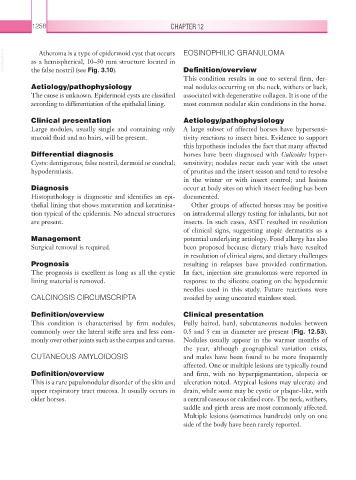Page 1283 - Equine Clinical Medicine, Surgery and Reproduction, 2nd Edition
P. 1283
1258 CHAPTER 12
VetBooks.ir as a hemispherical, 10–50 mm structure located in
Atheroma is a type of epidermoid cyst that occurs EOSINOPHILIC GRANULOMA
Definition/overview
the false nostril (see Fig. 3.10).
This condition results in one to several firm, der-
Aetiology/pathophysiology mal nodules occurring on the neck, withers or back,
The cause is unknown. Epidermoid cysts are classified associated with degenerative collagen. It is one of the
according to differentiation of the epithelial lining. most common nodular skin conditions in the horse.
Clinical presentation Aetiology/pathophysiology
Large nodules, usually single and containing only A large subset of affected horses have hypersensi-
mucoid fluid and no hairs, will be present. tivity reactions to insect bites. Evidence to support
this hypothesis includes the fact that many affected
Differential diagnosis horses have been diagnosed with Culicoides hyper-
Cysts: dentigerous, false nostril, dermoid or conchal; sensitivity; nodules recur each year with the onset
hypodermiasis. of pruritus and the insect season and tend to resolve
in the winter or with insect control; and lesions
Diagnosis occur at body sites on which insect feeding has been
Histopathology is diagnostic and identifies an epi- documented.
thelial lining that shows maturation and keratinisa- Other groups of affected horses may be positive
tion typical of the epidermis. No adnexal structures on intradermal allergy testing for inhalants, but not
are present. insects. In such cases, ASIT resulted in resolution
of clinical signs, suggesting atopic dermatitis as a
Management potential underlying aetiology. Food allergy has also
Surgical removal is required. been proposed because dietary trials have resulted
in resolution of clinical signs, and dietary challenges
Prognosis resulting in relapses have provided confirmation.
The prognosis is excellent as long as all the cystic In fact, injection site granulomas were reported in
lining material is removed. response to the silicone coating on the hypodermic
needles used in this study. Future reactions were
CALCINOSIS CIRCUMSCRIPTA avoided by using uncoated stainless steel.
Definition/overview Clinical presentation
This condition is characterised by firm nodules, Fully haired, hard, subcutaneous nodules between
commonly over the lateral stifle area and less com- 0.5 and 5 cm in diameter are present (Fig. 12.53).
monly over other joints such as the carpus and tarsus. Nodules usually appear in the warmer months of
the year, although geographical variation exists,
CUTANEOUS AMYLOIDOSIS and males have been found to be more frequently
affected. One or multiple lesions are typically round
Definition/overview and firm, with no hyperpigmentation, alopecia or
This is a rare papulonodular disorder of the skin and ulceration noted. Atypical lesions may ulcerate and
upper respiratory tract mucosa. It usually occurs in drain, while some may be cystic or plaque-like, with
older horses. a central caseous or calcified core. The neck, withers,
saddle and girth areas are most commonly affected.
Multiple lesions (sometimes hundreds) only on one
side of the body have been rarely reported.

